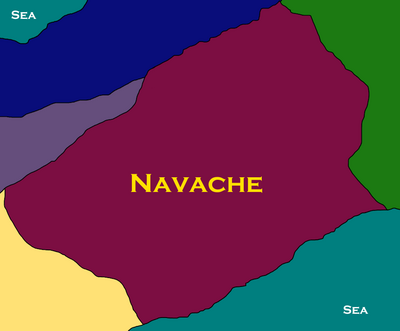Navache
This article is incomplete because it is pending further input from participants, or it is a work-in-progress by one author. Please comment on this article's talk page to share your input, comments and questions. Note: To contribute to this article, you may need to seek help from the author(s) of this page. |
Homelands of the Navacheans Dę́ę́ Naashá | |
|---|---|
 Location of Navache | |
| Location | North kalavik |
| Largest Fortified Village | Tsin Názt'i' |
| Recognised regional languages | De Yáshtiʼ Tkoh Yáshtiʼ |
| Ethnic groups | Navache
Howache Possanac Numerous other tribes |
| Religion | Religion |
| Demonym(s) | Di’Din |
| Government | Tribal |
• Chief/Chieftain/High Chief | Cassadore(Navache), and many others |
| Independent Tribes | |
• Tribal | Ancient |
• Tribal | Modern |
| Population | |
• Estimate | 4,000,000 |
• Density | 10.25/km2 (26.5/sq mi) |
| Currency | Łį́į́ʼ |
The Homelands of the Navacheans(Tkoh Yáshtiʼ: Dę́ę́ Naashá) also simply known as Navache, as that tribe is the tribe that holds the most influence while also being fairly close to the coast, is a section of land in Northern Kalavik whose people share many cultural ties. As such, they are not a unified nation. This also leads to the borders of what exactly the homelands are being fuzzy at best often, as the various nomadic and semi nomadic tribes can be hard to pin down exactly.
However, the tribes are not fully disorganized. Each tribe is organized in and of itself, and some of the more powerful tribes, such as the Navache and the Howache, hold influence over many of their smaller neighboring tribes. However, even the mightiest of the tribes have little interest in the outside world, and thus the tribes have had little contact with anyone not nearby to them.
Etymology
The Navache term Dę́ę́ Naashá, which is what they use to refer to where they live, is the Tkoh Yáshtiʼ word for “Where One Lives”, or simply “home”. Other tribes use very similar names. The lack of a unified state means that there is no one tribe which all of the tribes refer to the land by the name of, though foreigners may latch onto a particular tribe and use its name.
History
Subheading 1
Subheading 2
Subheading 3
Geography
Demographics
Government
The tribes Dę́ę́ Naashá are a disunified collection. However, each tribe is generally tight knit. While this can vary from tribe to tribe in intensity, it will exist in some form. Many of the smaller tribes are closer to large families, and this dynamic often continues even once they become larger and more powerful.
Tribes are generally led by a chief, chieftain, high chief, or whatever they determine to call their leader. Not all chiefs get their position in the same manner. Some tribes have it pass down hereditarily, while others have the current chief appoint the next chief, while still yet others have the tribes elders decide on a chief once the old chief has passed away.